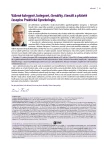Kardiovaskulární změny v těhotenství
I. Těhotenství zvyšuje riziko nemocí srdce a cév
Authors:
Liana Greiffeneggová 1,2; Drahoslava Hrubá 2
Authors‘ workplace:
Katedra porodní asistence a zdravotnických záchranářů, Lékařská fakulta MU
1; Ústav ochrany a podpory zdraví, Lékařská fakulta MU
2
Published in:
Prakt Gyn 2016; 20(2): 81-83
Category:
Gynecology and Obstetrics
Overview
Pregnancy is associated with many changes in the maternal circulation, some of them have an elevated risk of cardiovascular diseases both during pregnancy as well as many years postpartum. Statistic evidence suggests that in developed countries, the rate of acute myocardium infarction is 6 cases per 100.000 deliveries, the rate of stroke is more than 30 cases per 100.000 deliveries and venous thrombosis occur in 2 cases per 1.000 deliveries. The risk substantially rises with the age of pregnant women, these complications have more severe prognosis in developing countries.
Key words:
epidemiologic evidence – cardiovascular disease – possible pathways – prevention – pregnancy
Sources
1. James AH. Venous thromboembolism in pregnancy. Thromb Vasc Biol 2009; 29(3): 326–331.
2. James AH, Jamison MG, Biswas MS et al. Acute myocardial infarction in pregnancy. A Unites States population-based study. Circulation 2006; 113(12): 1564–1571.
3. Zhou Y, Damsky CH, Fisher SJ. Preeclampsia is associate with failure of human cytotrophoblast to mimic a vascular adhesion phenotype: ona cause of defective endovascular invasion in this syndrome? J Clin Invest 1997; 99(9): 2152–2164.
4. Powe CE, Levine RJ, Karumanchi SA. Preeclampsia: a disease of the maternal endothelium. The role of antiangiogenic factors and implications for later cardiovascular disease. Circulation 2011; 123(24): 2856–2869.
5. Herig A, Berkane N, Lefevre G et al. Maternal serum sFlt-1 concentration is an early and reliable predictive marker of preeclampsia. Clin Chem 2004; 50(9): 1702–1703.
6. Karumanchi SA, Levine RJ. How does smoking reduce the risk of preeclampsia? Hypetension 2010; 55(5): 1100–1101.
7. Signore C, Mills JL, Qian C et al. Circulating angiogenic factores and placental abruption. Prenat Diagn 2008; 28(9): 852–858.
8. James AH, Bushnell ChD, Jamison MG et al. Incidence and risk factors for stroke in pregnancy and the puerperium. Obstet Gynecol 2005; 106(3): 509–516.
9. Wiebwrs DO, Whisnant JP. The incidence of stroke among pregnant women in Rochester, Minn, 1955 through 1979. JAMA 1985; 254(21): 3055–3057.
10. Kittner SJ, Stern BJ, Feeser BR et al. Pregnancy and the risk of stroke. N Engl J Med 1996; 335(11): 768–774.
Labels
Paediatric gynaecology Gynaecology and obstetrics Reproduction medicineArticle was published in
Practical Gynecology

2016 Issue 2
Most read in this issue
- Selected orthopaedic indications for caesarean section
- Agents DT56a – an ideal phytoSERM for treatment of estrogen deficit
- Women’s experience of abortion
-
Kardiovaskulární změny v těhotenství
I. Těhotenství zvyšuje riziko nemocí srdce a cév
